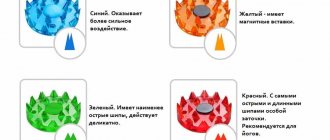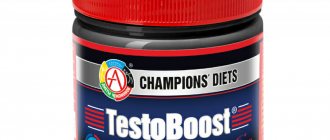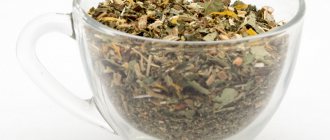Types of sports nutrition
Let's start by finding out what sports nutrition is. In fact, this is not food, but just a dietary supplement to food. Obviously, there is no point in taking dietary supplements in cases where the diet includes all the elements necessary for the body in sufficient quantities. However, people actively involved in sports have an increased need for many of these substances. This is especially true for proteins. Sports nutrition is designed to satisfy this need.
Depending on what substances are supplied to the body by tablet, powder or cocktail, sports nutrition can be divided into several categories:
- protein shakes (provide the protein necessary for muscle growth);
- amino acids (play essentially the same role as protein);
- gainers (protein-carbohydrate cocktails), which perform two tasks: muscle growth and restoration of strength spent during training;
- energy drinks (increase the body’s endurance);
- vitamin and mineral complexes;
- fat burners;
- special drugs (often hormonal) that have a narrowly targeted effect.
Some believe that sports nutrition also includes anabolics - synthetic drugs that replace testosterone - a male hormone that stimulates a number of processes in the body, including the growth of muscle mass. In fact, anabolic steroids are classified as doping drugs; their use in sports is prohibited, so they cannot be considered sports nutrition.
Why amateur athletes don’t need sports nutrition
The sports nutrition industry is sweeping across the planet, even despite the terrifying rise in prices for foreign products, which, by the way, has stimulated our manufacturers (we firmly believe in their integrity), every self-respecting athlete has at his disposal one or more colorful jars or bags of concentrated protein , and there is actually nothing wrong with this, because everyone, even a semi-literate kid from the area who visits the local “rocking chair”, has long known that if there is no protein, there are no muscles either.
Moreover, you and I, as consumers and Internet users who are constantly stewing in sports and near-sports juice due to our lifestyle, are constantly, one might say, under massive information bombardment, the purpose of which will make us believe in the indispensability and necessity of tasty, rich protein powders, which are praised during breaks by athletes of all federations and stripes (their job is to advertise sports).
And here, naturally, a tricky but quite logical question arises in any inquiring mind: do I really need sports nutrition (in this particular case, protein)?
Let's figure it out. It is no coincidence that the title of the article contains the phrase “amateur athletes,” because now we are talking about ordinary gym visitors who work out, as they say, “for themselves,” and it is assumed that amateur athletes do not use pharmaceuticals. support and, accordingly, do not have huge hypertrophied muscle mass, the so-called natural bodybuilders, for the most part, are strong guys, but by no means huge.
The essence of the question is generally clear and lies in a simple question - how much protein should a training athlete consume to progressively build muscle mass. A long-known cliché, uttered thousands of times, by thousands of athletes and methodologists, immediately comes to mind, the notorious statement that has already become almost a sacred mantra: 2 grams of protein per kilogram of body weight.
The statement cannot be called erroneous, since it is very reasonable, because an athlete a priori needs to consume more protein than an ordinary citizen to satisfy basic needs, this indicator is usually taken as 1 gram of protein per kilogram of body weight. That is, an athlete needs twice as much protein, quite logical, and we could stop there, but as always there is a but. Namely, one that will allow us to connect the initial thesis about the need for sports nutrition and real protein consumption (we are talking about a quantitative indicator, and not about specific amino acids). The task has been set.
For some reason, no one takes into account several important things in this dogmatic statement:
- The weight of an athlete.
- The mass of muscle tissue, which can have a varying percentage of total body weight.
- The level of androgenic hormones, including testosterone, which triggers the process of synthesis of its own protein.
- Secretion of somatotropin, which enhances protein synthesis and inhibits its breakdown.
- Training schemes and predominant types of training load. How we train directly determines what and how much our body requires for recovery and supercompensation.
These are the five main factors that determine the protein requirement of an amateur athlete’s body. The first two can be called morphological, and they could, in principle, be combined into one point, designated as the ratio of muscle to body weight, but since we are talking about protein consumption per 1 kilogram of body weight, I deliberately separated them. The third and fourth are genetic and are determined by heredity and, as a result, are not subject to adjustment (it is impossible to change this without the use of hormonal drugs) and will not exceed their maximum programmed values during a person’s life. The fifth factor is the most flexible and is the athlete’s main multifunctional tool for performing assigned training tasks.
The more an athlete weighs, the more protein he should consume, you can’t argue with that, but is the qualitative progression of 2 g per kg correct or is it just a quantitative indicator?
According to the Methodological Recommendations MP 2.3.1.2432 -08 on the physiological needs for energy and nutrients for various groups of the population of the Russian Federation (I think the people who compiled them can be trusted), we have a protein requirement for an adult male from 65 to 117 years old, The spread, you see, is large, it is explained by the level of physical activity according to the physical activity coefficient and body weight. In this case, we are talking about the body’s basic need for protein in the metabolic process (blood creation, renewal of existing tissues, catalyzing chemical processes in the body, etc.)
If we talk about indicators as the ratio of the amount of protein to a kilogram of body weight, then we will talk about 0.9–1.3 grams per kilogram without taking into account the person’s weight, a sort of average consumption indicator. We took the average basic need as 0.9–1.3 grams per kilogram, taking into account the coefficient of physical activity of groups I and II, 1.4 and 1.6, respectively, but without taking into account training activity (since I am convinced that most users resource and gym visitors as a whole fall into these groups).
So, 1 gram. Athletes weighing 60, 70, 80, kilograms should consume at least 54–78, 63–91, 72–104, on average, the basic protein requirement without taking into account training activity is 66, 77 and 88 grams of protein, respectively, but are they required to consume 120 , 140, 160 grams of protein per day?
Let’s take from the same recommendations the approximate basic energy expenditure of men, expressed in kilocalories. For 60, 70, 80 kg men this is 1590, 1750, 1920 kcal. in a day. Multiplying basic energy expenditure by coefficients, we get a range of 2226–2544, 2450–2800, 2688–3072 for 60, 70, and 80 kg men, respectively. Now let’s calculate how many of these costs according to the protein requirement of 0.9–1.3 grams per kilogram will be covered by protein, so as not to get confused at all in the numbers, let’s perform an acceptable averaging of the data. For 60, 70, 80 kilogram men, the average consumption will be 2385, 2625, 2880 kcal, and the average protein requirement for all is 1.1 grams per kilogram of body weight. By simple calculations we obtain the following figures: 264 kcal, 308 kcal, 352 kcal for each case, which as a percentage is 11.1%, 11.7% and 12.2% of the total optimal diet, covering energy costs without deficit or surplus.
Now let’s add a training load (strength training aimed at muscle fiber hypertrophy), the cost of which is 200–400 kcal, on average we take 300 kcal. We are only 300 calories over consumption! Which is covered by the body due to energy phosphates, glycogen reserves and partly through the oxidation of fats. In order to reduce debit to credit, so to speak, we need to increase the consumption of nutrients, including protein, but maintaining the percentage ratio. In this case, we get an average of 1.2 grams of protein per kilogram of body weight for all weight groups.
But if an athlete aims to increase muscle volume, he must ensure a surplus in daily calories, including proteins. The question is how much should he add for quality growth?
The average weight gain for an 80-kilogram athlete is 10–15 kg. per year, let’s say that this athlete has an average quality of, say, 10–12% (how many of you look decent all year round, and not just during the drying period?) subcutaneous fat, that is, it turns out that he will add 8 to lean muscle mass ,9–13,35. Here it is necessary to give an important clarification that this scatter is limited by genetic factors and training methods, which are not used in these calculations, since they do not have numerical indicators that satisfy the calculations, but they should not be discounted, since they are based on the figure obtained at the end have a major, determining influence.
So, again, the average increase in lean muscle mass is 11.125 kilograms per year (wow mutant) or 30 g per day. The basic need of an 80-kilogram athlete, according to our calculations, is 96 grams of protein, now we add to this the 30 grams that need to be synthesized and we get 126 grams of need. Let's make a simple equation 126=80*X, where 80 is the athlete's mass, and x = the number of grams of protein per kilogram of body weight. We get 1.575g. We round up and get an average of 1.6 grams of protein per kilogram.
Although the data in the calculations are averaged and the progression of the athlete’s body weight was omitted in the last calculation of the requirement, the figure of 1.6 grams is very close to the truth, which can fluctuate down or up for each individual athlete, taking into account the factors I outlined above (hormone levels, workout). By sticking to this figure, essentially the absolute coefficient of protein requirement (no matter how pretentious it may sound), the athlete can hope for a qualitative increase in muscle mass while maintaining other things equal (caloric intake, recovery, etc.) and forget about the 2 grams that are inflated in most cases and just space 3 and 4, designated by “literate” athletes and methodologists.
Conclusions:
Ensuring the necessary protein intake according to this average coefficient can be achieved using a properly structured nutrition system from ordinary foods familiar to every person, and the use of sports nutrition, to put it mildly, is not advisable, including in economic terms.
What are sports dietary supplements made from?
Manufacturers of sports dietary supplements claim that they are based on natural food products of plant or animal origin (meat, egg or soy protein, caffeine obtained from tea or coffee, other substances). Based on this, they conclude that sports nutrition is no more harmful than regular food, and the only contraindication to its use may be individual intolerance, expressed by indigestion or food allergies.
It is not easy to check their words, since there are no GOST standards for sports nutrition, and, in fact, no one controls its quality.
In America, where some independent organizations are involved in testing sporpitis, these products often contained synthetic substances not specified by the manufacturers that could cause considerable harm to the body.
What should the buyer do? If the decision to use sports dietary supplements has been made, preference should be given to products from well-known manufacturers that have proven themselves well. In this case, the risk of eating something wrong is significantly reduced.
Benefits, harms, contraindications and side effects
Sports dietary supplements have different effects on the body. Each of them, solving the tasks for which they are hired, brings certain benefits. Sports dietary supplements help you lose weight, make muscles more prominent, restore strength, increase the body's endurance, and build muscles.
It must be said that you shouldn’t expect miracles from sports nutrition: if you don’t go to the gym, you won’t achieve success, no matter how many liters of protein shake you drink. On the other hand, you can build muscle without using dietary supplements; you just need to build your diet correctly.
However, each product also has its own specific contraindications.
- Thus, energy drinks are contraindicated for those who have problems with the cardiovascular system. They are capable of creating these problems themselves if they are used uncontrollably. They should not be taken by hypertensive patients or people with a weak heart.
- Protein intake puts increased stress on the liver and kidneys. If you already have kidney or liver failure, taking protein shakes will only make the problem worse.
- Amino acids are contraindicated for people with diseases of the gastrointestinal tract.
- Gainers should not be taken by people with metabolic disorders or diseases of the endocrine system. They are especially dangerous for patients with diabetes.
- Particularly dangerous are anabolic steroids and synthetic additives, the inclusion of which in products is usually kept silent by the manufacturer. We are talking about steroids and similar substances. They significantly increase the risk of cancer, especially in men, and have a negative effect on potency. It is with them that the widespread popular opinion about the extremely high harm of sports nutrition is associated.
In any case, it makes sense to inform your doctor about your intention to start taking sports nutrition. If he tries to dissuade you, it makes sense to listen to his opinion.
In addition, even without contraindications, sports nutrition can cause a negative reaction in the body:
- allergies;
- nausea;
- diarrhea;
- flatulence;
- constipation;
- heartburn.
This is due to the fact that the body is not used to receiving the substances it needs in its pure form, so sports nutrition is absorbed differently than regular food.
Unpleasant side effects can also occur if you take dietary supplements in violation of the manufacturer’s recommendations. Taking low-quality products and expired medications will also not lead to anything good.
Chemistry for the body
So what exactly is sports nutrition? To answer, you need to understand what is necessary for the full functioning of the body. And you need proteins (protein), fats, carbohydrates, vitamins, microelements. Everyone knows this. Just like the fact that carbohydrates and fats are energy, and proteins are building materials for cells. Including muscle. That is, for success in bodybuilding you need protein and carbohydrates. It's clear.
But not everyone knows that proteins consist of amino acids, special organic compounds. Each type is built from its own combination of amino acids. In total, there are from 22 to 24 types of such compounds, of which 8-10 are considered essential. That is, those that are needed for the body, but are not synthesized in it - a person receives them from food, mainly of animal origin. The best source of amino acids is meat, fish, and dairy products. They are the basis of sports nutrition. And, in principle, by eating cottage cheese, chicken breast, and so on, you can do without buying protein shakes, which, in fact, are just a mixture, balanced, complete, and capable of replenishing the lack of protein in the body. Eating protein will provide the same benefits as eating chicken or veal.
But don't forget about carbohydrates. This is energy in its pure form, without which any processes are impossible. It can be obtained from various sources; in fact, any product contains a certain amount of carbohydrates.
But such substances are also different, some break down faster, others slower, and their optimal combination is used for different purposes. Again, this can be achieved through a balanced diet. But carbohydrates are those substances whose quantity is strictly controlled (an excess is fraught with the deposition of subcutaneous fat). Therefore, many people prefer to get them from sports nutrition, which, moreover, is absorbed faster than oatmeal or a banana.
The body also needs vitamins, microelements and other useful substances, which, again, can be obtained from regular food. Or from sports nutrition, and professionals recommend the latter option.
Doctors' opinion on the dangers of sports nutrition
Medical opinions about the benefits and harms of sports nutrition are divided. Scientists, “fed” by sellers and manufacturers of sports nutrition, confirm their statements about the safety and even usefulness of sports dietary supplements, about the naturalness of their composition.
Attending physicians who have nothing to do with this business often become opponents of sports nutrition. It is understandable that they are afraid of facing the possible negative consequences of their patients using active food additives. It is possible that many of them simply want to play it safe and insure their patient.
It is difficult to find independent experts, but if the opinion of doctors regarding the harm of sports nutrition is important to you, we will present the results of a survey conducted by one of the Internet portals.
- According to its results, every second nutritionist said that sports nutrition is intended specifically for professional athletes, but ordinary people should not include it in their diet.
- Every third doctor considered that sports dietary supplements do not pose a great danger, and everyone can take them, provided that they have no contraindications to this.
- Other doctors advise giving up sports nutrition so as not to harm your health, and this advice applies even to those who play sports professionally.
It’s up to you to decide how justified your use of sports nutrition is. If you do decide to try to include them in your diet, try to reduce the risk of negative consequences.
How to reduce side effects and possible harm
As already mentioned, it is not recommended to buy cheap dietary supplements of dubious production. However, even if you use expensive sports nutrition, you are not immune from unwanted consequences. To reduce the risk of occurrence, adhere to the following rules:
- do not take dietary supplements in large quantities exceeding the natural needs of the body (1.5-2 g of protein for men, 1.2-1.5 g of protein for women per 1 kg of body weight excluding body fat);
- divide the daily dose of sporpit into portions, distributing them throughout the day;
- time the use of sports nutrition with your regular meals;
- Wash down foods containing a lot of fiber (for example, apples) with protein shakes;
- do not take several types of dietary supplements at once, especially those acting identically or, on the contrary, in the opposite way;
- The duration of a sports nutrition course should not be more than three months, the break between courses should not be less than their duration.
I can give you one more piece of advice: don’t buy a lot of a product that’s new to you at once. Take a sample of a small package to check how your body reacts to the new product and how acceptable its taste is to you.
Share
- 2
The right approach
Sports supplements are an expensive pleasure, but necessary due to their effectiveness. But they must demonstrate this effectiveness. To do this, you need to take them correctly. In many cases, an important component of success is the optimal distribution of training loads. The attitude - the more you use, the better - is not suitable. For example, let's take a few popular supplements.
Protein
The most beneficial whey protein is in the morning after waking up, in the afternoon after training, before bed - casein protein, preferably micellar protein. Serving dose: 0.3 g of protein per 1 kg of weight.
BCAAs
BCAA's are most effective in a 2:1:1 ratio. No more than 15 g is absorbed at a time. BCAA is optimally taken before, during and after training. As for BCAA forms, powder is better. Capsules and tablets are the same powder, but more expensive. Liquid BCAA contains more preservatives and stabilizers.
Glutamine
About 5 g of this amino acid is absorbed at a time. But this product is fuel for the small intestine and immune cells. It is better to take one dose immediately after training along with BCAA.
Carnitine
Its effectiveness directly depends on the metabolic rate and the body's need to extract energy from fats. From this it is clear that carnitine will only work if there is active training. Without physical activity, it will be money thrown away. It is better not to exceed the recommended dosage (2 g per day), as this can lead to problems with the gastrointestinal tract.
Creatine
This is the most effective supplement for increasing strength and accelerating muscle growth. The best form of creatine in sports nutrition is creatine monohydrate. It is optimal in terms of efficiency-price ratio.
The course of treatment is 6–8 weeks (then 4–6 weeks of rest). The absorption of creatine does not depend on loads and time of day, so a single dose of 5–6 g: immediately after training; on a non-training day - in the morning after waking up.
Beta-alanine
This amino acid is found in many pre-workout supplements. It is best taken with creatine. It neutralizes lactic acid, meaning it increases strength endurance and speeds up recovery. The amino acid is positive for 4–5 weeks. Then a break - 2-4 weeks. Dosage - 3-4 g per day in 2 doses with a break of 8 hours.










